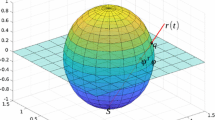Abstract
This paper presents a new method to solve the relative pose between two images, using three pairs of homologous points and the knowledge of the vertical direction. The vertical direction can be determined in two ways: The first requires direct physical measurements such as the ones provided by an IMU (inertial measurement unit). The other uses the automatic extraction of the vanishing point corresponding to the vertical direction in an image. This knowledge of the vertical direction solves two unknowns among the three parameters of the relative rotation, so that only three homologous couples of points are requested to position a couple of images. Rewriting the coplanarity equations thus leads to a much simpler solution. The remaining unknowns resolution is performed by “hiding a variable” approach. The elements necessary to build a specific algebraic solver are given in this paper, allowing for a real-time implementation. The results on real and synthetic data show the efficiency of this method.
Similar content being viewed by others
References
Antone, M., Teller, S.: Automatic Recovery of Relative Camera Rotations for Urban Scenes, vol. 02, pp. 282–289. IEEE Computer Society, Los Alamitos (2000)
Barnard, S.T.: Interpreting perspective images. Artif. Intell. 21, 435–462 (1983)
Batra, D., Nabbe, B., Hebert, M.: An Alternative Formulation for Five Point Relative Pose Problem, pp. 21–21 (2007)
Cox, D., Little, J., O’Shea, D.: Ideals, Varieties, and Algorithms, 3rd edn. Undergraduate Texts in Mathematics. Springer, New York (2007)
Elkadi, M., Mourrain, B.: Symbolic-numeric methods for solving polynomial equations and applications. In: Dickenstein, A., Emiris, I.Z. (eds.) Solving Polynomial Equations: Foundations, Algorithms, and Applications, pp. 124–168 (2005)
Fischler, M.A., Bolles, R.C.: Random sample consensus: A paradigm for model fitting with applications to image analysis and automated cartography. Commun. ACM 24(6), 381–395 (1981)
Hartley, R.I., Zisserman, A.: Multiple View Geometry in Computer Vision, 2nd edn. Cambridge University Press, Cambridge (2004)
Kalantari, M., Jung, F., Paparoditis, N., Guédon, J.P.: Robust and automatic vanishing points detection with their uncertainties from a single uncalibrated image, by planes extraction on the unit sphere. In: IAPRS, Beijing, China, vol. 37 (Part 3A), pp. 203–208 (2008)
Kukelova, Z., Bujnak, M., Pajdla, T.: Polynomial eigenvalue solutions to the 5-pt and 6-pt relative pose problems (2008)
Li, H.D., Hartley, R.I.: Five-Point Motion Estimation Made Easy, pp. I: 630–633 (2006)
Lobo, J., Dias, J.: Vision and inertial sensor cooperation using gravity as a vertical reference. IEEE Trans. Pattern Anal. Mach. Intell. 25(12), 1597–1608 (2003)
Lowe, D.G.: Distinctive image features from scale-invariant keypoints. Int. J. Comput. Vis. 60(2), 91–110 (2004)
Lutton, E., Maitre, H., Lopez-Krahe, J.: Contribution to the determination of vanishing points using Hough transform. IEEE Trans. Pattern Anal. Mach. Intell. 16(4), 430–438 (1994)
Nistér, D.: An efficient solution to the five-point relative pose problem. IEEE Trans. Pattern Anal. Mach. Intell. 26(6), 756–777 (2004)
Philip, J.: A non-iterative algorithm for determining all essential matrices corresponding to five point pairs. Photogramm. Rec. 15(88), 589–599 (1996)
Schaffalitzky, F., Zisserman, A.: Planar grouping for automatic detection of vanishing lines and points. Image Vis. Comput. 18, 647–658 (2000)
Segvic, M., Schweighofer, G., Pinz, A.: Performance evaluation of the five-point relative pose with emphasis on planar scenes. In: Performance Evaluation for Computer Vision, Workshop of the Austrian Association for Pattern Recognition, Austria, pp. 33–40 (2007)
Shufelt, J.A.: Performance evaluation and analysis of vanishing point detection techniques. IEEE Trans. PAMI 21(3), 282–288 (1999)
Stewénius, H.: Matlab code for solving the fivepoint problem. http://vis.uky.edu/~stewe/FIVEPOINT/
Stewénius, H., Engels, C., Nistér, D.: Recent developments on direct relative orientation. ISPRS J. Photogramm. Remote Sens. 60(4), 284–294 (2006)
Strecha, C., von Hansen, W., Van Gool, L.J., Fua, P., Thoennessen, U.: On Benchmarking Camera Calibration and Multi-view Stereo for High Resolution Imagery, pp. 1–8 (2008)
Triggs, B.: Routines for relative pose of two calibrated cameras from 5 points. Technical report, INRIA (2000)
van den Heuvel, F.A.: Vanishing point detection for architectural photogrammetry. Int. Arch. Photogramm. Remote Sens. 32(5), 652–659 (1998)
Vieville, T., Clergue, E., Facao, P.E.D.: Computation of ego motion using the vertical cue. Mach. Vis. Appl. 8(1), 41–52 (1995)
Author information
Authors and Affiliations
Corresponding author
Rights and permissions
About this article
Cite this article
Kalantari, M., Hashemi, A., Jung, F. et al. A New Solution to the Relative Orientation Problem Using Only 3 Points and the Vertical Direction. J Math Imaging Vis 39, 259–268 (2011). https://doi.org/10.1007/s10851-010-0234-2
Published:
Issue Date:
DOI: https://doi.org/10.1007/s10851-010-0234-2




